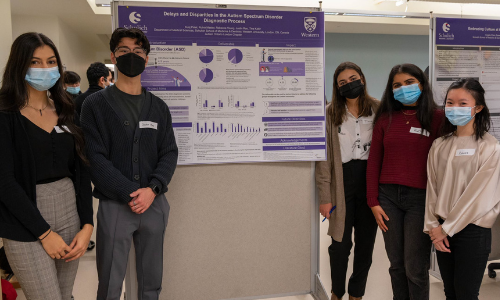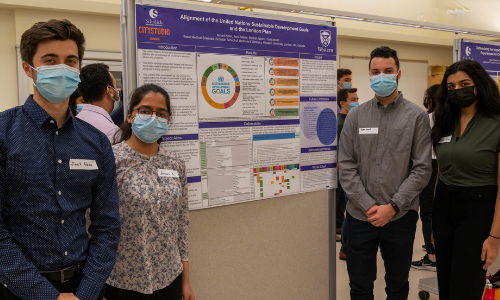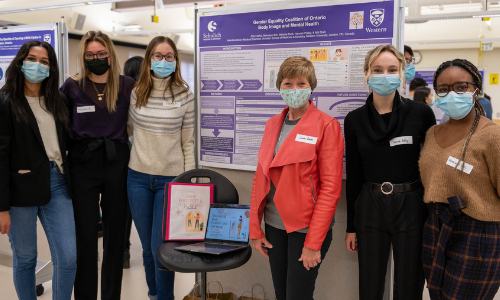Feature: Tackling London’s health challenges through community-engaged learning
A community-engaged learning course for undergraduate medical science students is connecting learners with the London community to address some of the Forest City’s pressing health issues.
Schulich Medicine & Dentistry’s Medical Sciences 4300 course, Addressing Healthcare Misconceptions using Scientific Inquiry, sees students partner with community organizations, including Autism Ontario, London-Middlesex EMS and CityStudio, on semester-long projects.
Working collaboratively, students and their partners tackle projects designed to expand students’ views of health care while learning about issues in the broader community.
 The course’s professor, Sarah McLean, PhD’12, says the projects allow students to contribute to the community and applying their learning in a tangible way, while community organizations benefit from students’ expertise and passion.
The course’s professor, Sarah McLean, PhD’12, says the projects allow students to contribute to the community and applying their learning in a tangible way, while community organizations benefit from students’ expertise and passion.
“A lot of students have told me that this learning experience is the most pivotal one for them in their undergrad,” McLean said. “It gives them a much better perspective of who is involved in a community and what the needs of a community are.”
Now in its fifth year, the course has grown to include 16 community partners with the help of Jedd Sardido, the School’s Experiential Learning Coordinator. This year, 83 students undertook 17 projects.
Through class-based learning and guest lectures, students also explore topics including the social determinants of health and health literacy and how they impact the London and Southwestern Ontario communities.
“To be an effective health care provider or scientist, you need to know the community you are serving,” McLean said. “The uniqueness of peoples’ stories matters. This CEL course is one way to expose students to that and really get them to think about it.”
Identifying barriers to autism care
Kunj Patel was drawn to the community engaged learning course out of a desire to put her previous undergraduate learning to the test.
“This was a chance for me to apply my knowledge and go out and see the community,” she said. “What you learn in school doesn’t always translate 100 per cent to how you’d apply it to the community. There’s a lot of other factors that come into play when you’re applying it in the real world.”
For their project, Patel’s group worked with Autism Ontario’s London chapter to assess barriers to accessing an autism diagnosis in the city.
The group developed a survey and distributed it to families in London that have children with autism to determine how long it took from when they first sought out care for their child to when they received a diagnosis.
They also worked with groups across Ontario to conduct research on the topic.
The team found wait times to see specialists were one of the biggest barriers, but also noted families with lower incomes found it harder to seek out care.
Patel said the information they discovered could be used to develop potential solutions to improving care for children with autism.
“It was nice to see the work you’re doing is helping someone. Our work is actually making a difference,” she said. “It also helps you build connections in the community.”
Coming from the Greater Toronto Area to attend Western University, Patel said the class also pushed her off campus and out into the city.
As an aspiring physician, the course helped show her how health care extends beyond clinical settings.
“Health care problems at the community level are not always biological, they can be social; ethnicity comes into play and income is a big factor,” she explained.
For Patel, one of the most impactful moments of the semester was a guest speaker who had experienced homelessness for 25 years.
“It really brought into perspective how privileged we are and that we need to be more mindful about the community,” she said.
Analyzing the London Plan with a sustainability lens
Fourth year student Trent Arnold was part of a group working with CityStudio London to analyze the London Plan through the lens of the United Nation’s sustainable development goals.
The London Plan is the city’s official planning document.
 “The U.N. has sustainable development goals and we wanted to map the most popular goals in the London Plan, looking at which targets are the most common and some that the city isn’t working at,” Arnold said.
“The U.N. has sustainable development goals and we wanted to map the most popular goals in the London Plan, looking at which targets are the most common and some that the city isn’t working at,” Arnold said.
His team also produced summaries of the London Plan, making a more than 400-page document accessible for the public.
“We’re giving a simplified view to the public to understand what their city is doing, but also giving a critical lens back to the city on their own work,” Arnold explained.
Through CityStudio, Arnold hopes city officials take note of the areas for sustainability improvement they’ve identified in the London Plan.
“If I wasn’t doing this project in London, I would’ve remained in the dark about the ups and downs the city has had and the direction it has taken,” he said.
Developing a body image workshop for Londoners
“It’s been such a wonderful experience,” said Linda Davis, executive director of The Gender Equality Coalition of Ontario, on partnering with students for the community engaged learning course.
The coalition formed in 2019 with the goal of creating a grassroots movement calling for gender equality through awareness, initiatives and membership.

Davis worked with a group of five students to create a body image workshop – geared to all genders and identities – that could be delivered in the London community.
“We want to help people of all gender identities suffering from negative body image issues,” Davis explained. “There’s all kinds of mental health issues that go along with that.”
As a new organization, she said delivering the workshop (virtually, for now) would also allow the community to better understand the role of the Gender Equality Coalition.
“The students grasped very quickly what we wanted,” Davis said. “I have just been floored.”
She said the students have gained valuable experiences, including learning to ask the right questions, problem solving and managing stakeholder goals and expectations.
It’s also helped them to network and build connections within the London community, a boon as the fourth-year students prepare to graduate.
“It’s a win-win,” Davis said. “There’s a real benefit to us in the community to be engaged with students and have young minds and innovative thinking helping us.”
The case for a birthing centre in London
Amel Sassi’s team of five worked with Dynamic Doulas of London to create a pitch for a birthing centre in the city.
As deliverables, the group created a pitch deck and slideshow with all the necessary information, including statistics, a 3D floorplan and virtual tour, brochures and handouts.
“You really get to see it come to life,” Sassi said, adding the project helped her learn about the importance of rooting a birthing centre in equity, diversity and inclusion.
 She also learned about why some community members may be apprehensive about hospitals or the traditional health care system.
She also learned about why some community members may be apprehensive about hospitals or the traditional health care system.
“We all come from science backgrounds. We’re focused and driven, but we didn’t know much about business or what happens in the politics of health care,” Sassi explained.
She said working with Dynamic Doulas, conducting researching on cities with birthing centres and liaising with government officials has taught her the value of communication and interacting with those in the community.
“Being able to think critically about what is lacking in the community and what is needed for health care is incredibly valuable,” she said. “Now we see courses that are really coming to life and show medical science isn’t just about textbooks or facts.”
For Sassi, the project also allowed her to develop new skills outside the field of medical science. She said her team used various software, like AutoCAD, to generate the floorplan, and utilized additional programs to best display their information
The experience has also helped her better engage with the London community.
“When you come to Western, you often stay in this Western bubble,” Sassi said. “With this project, you get to see what the gaps are and what London needs and how you can contribute back.”
Through lectures, course work and her project, Sassi said she gained a better understanding of how factors like homelessness, food insecurity, culture and age contribute to the complexity of health care.
“That’s the amazing part of this course, it applies to everything,” she said. “You walk away such a well-rounded individual who can recognize different problems in the community and can adapt to make sure your solution is best suited for those in the community.”









